Ah, Shirdi. A hidden gem tucked away in Maharashtra, this charming town thrums with a special kind of energy. It’s no wonder millions flock here, their hearts drawn by the magic of Sai Baba. The air hums with a deep sense of peace, a spirituality that seeps into your soul.
But Shirdi is more than just a pilgrimage site. It’s a place steeped in history and culture, a vibrant tapestry woven from bustling markets and serene temples. Wander through the streets, and you’ll be enveloped by the warmth of the locals, their faith shining brightly. Whether you seek spiritual solace, a brush with the past, or simply a taste of authentic India, Shirdi has something for everyone.
How to reach:
Taking Flight: Shirdi boasts its own international airport just 15 kilometers away, making air travel a breeze. Catch connecting flights from major cities like Mumbai, Delhi, Hyderabad, and Bangalore. If you have more flexibility, Pune Airport (185 km distant) and Mumbai’s Chhatrapati Shivaji Maharaj International Airport (240 km away) also offer connections to Shirdi. Taxis and buses are readily available at all these airports to whisk you to your spiritual destination.
Train Travel Made Easy: Embark on your spiritual journey directly by train! Shirdi has its very own Sainagar Shirdi Railway Station, well-connected to major cities like Mumbai, Delhi, Chennai, and Bangalore. Regular trains like the Shirdi Express and Sainagar Shirdi Express make train travel a convenient choice. Upon arrival, auto-rickshaws and taxis are on hand to take you wherever you need to go within Shirdi.
Hitting the Road: For the adventurous traveler, Shirdi is easily accessible by car. A well-maintained network of highways connects the town to various locations. If you’re coming from Mumbai, it’s a scenic 5-6 hour drive (roughly 240 kilometers) via the Mumbai-Nashik Expressway and NH160. Pune is a bit closer, at 185 kilometers, taking approximately 4-5 hours on the Ahmednagar-Manmad Road.
Budget-Friendly Buses: A network of state-run and private buses makes Shirdi reachable for any budget. The Maharashtra State Road Transport Corporation offers frequent service from nearby cities like Mumbai, Pune, Nashik, and Aurangabad. Private operators provide a variety of comfortable and affordable options to suit your needs, including luxury and sleeper buses.
Best time to visit:
Winter: (October – February)
Winter offers the most comfortable weather for visiting Shirdi. Days are pleasantly cool, ranging from 8°C to 25°C, making it perfect for exploring temples and participating in outdoor activities. This season coincides with vibrant festivals like Dussehra and Sai Baba’s Punyatithi, immersing visitors in the rich cultural tapestry of Shirdi.
Monsoon: (June – September)
Monsoon transforms Shirdi into a verdant paradise with moderate to heavy rainfall. While the rain offers a refreshing break from the summer heat, it can sometimes disrupt travel and limit outdoor activities. However, for those who enjoy the monsoon’s charm and lush greenery, this can be a tranquil time to visit. Be prepared with rain gear and flexible plans to navigate the occasional downpour. The
Summer: (March – May)
Summer brings the least favorable weather to Shirdi, with temperatures reaching highs of 40°C. The intense heat can make daytime travel and exploring outdoors quite uncomfortable. If you do choose to visit during this time, plan temple visits for early mornings or evenings when temperatures are cooler.
Attractions:
Sai Baba Samadhi Mandir:
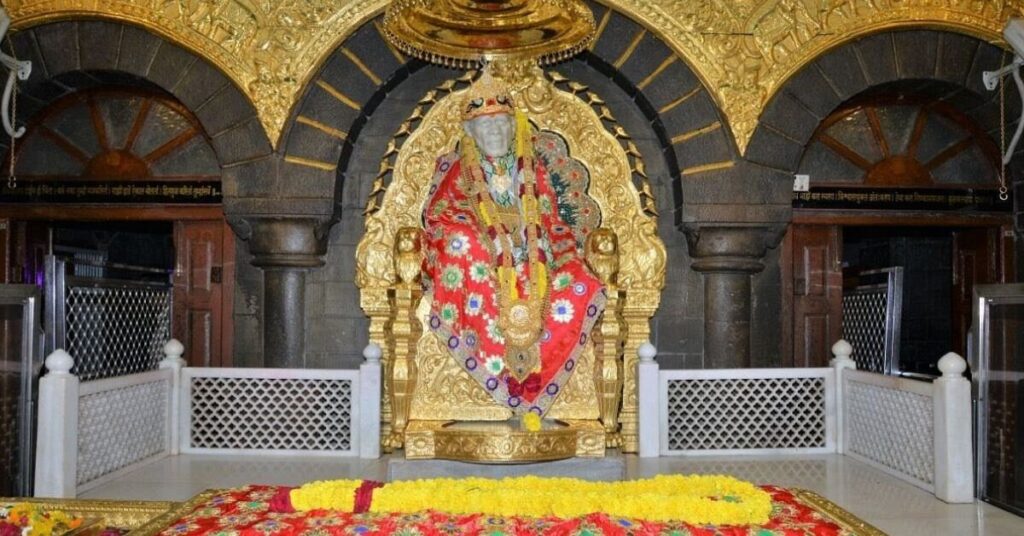
Shirdi’s heart and soul lies in the Sai Baba Samadhi Mandir, a pilgrimage destination for devotees worldwide. This revered temple houses the tomb of Sai Baba, the saint celebrated for his miracles and teachings of love, forgiveness, and charity. Simple yet serene architecture defines the Samadhi Mandir. A majestic white marble statue depicts Sai Baba in meditation, adorned in a golden robe.
Dwarkamai:
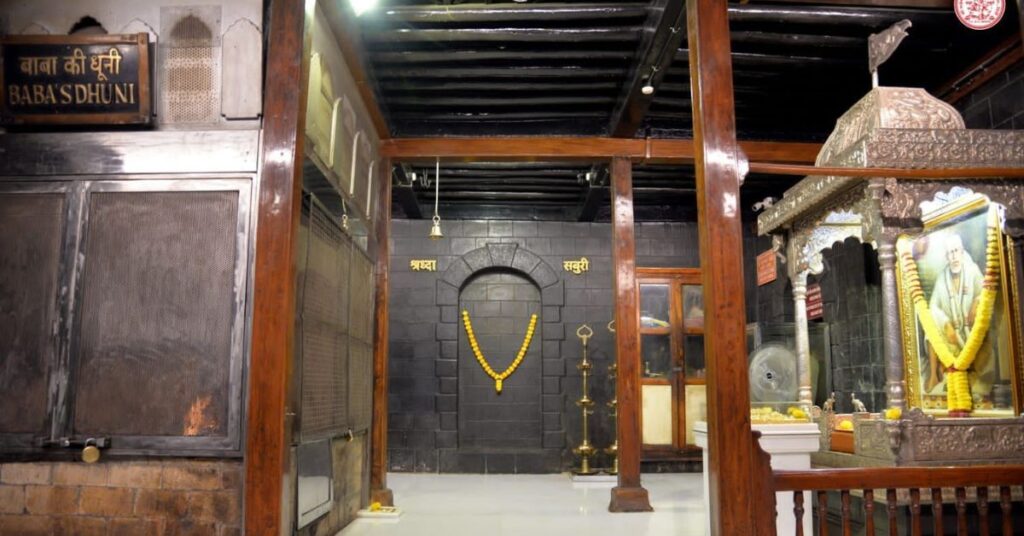
Step inside Dwarkamai, and you’re stepping back in time. This unassuming mosque, weathered by the decades, was Sai Baba’s home for over sixty years. Its very simplicity reflects the saint’s philosophy of living a life free of material clutter. The interior is a treasure trove of memories. The sacred fire (Dhuni) that Sai Baba lit himself still burns brightly, a constant reminder of his presence. Devotees revere the ash (Udi) from this fire, believing it holds healing powers.
Walk through the space, and you’ll find the walls adorned with portraits and sayings of Sai Baba. Each one whispers a story about his life and teachings. Look for the worn stone where Sai Baba used to sit – a testament to his humility and his connection with the ground beneath his feet.
Chavadi:
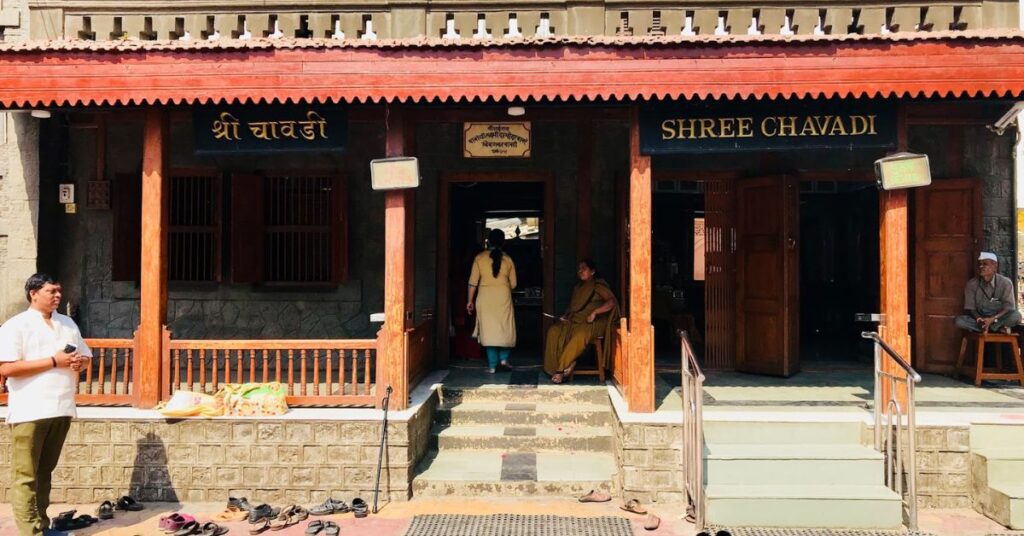
In Shirdi, nestled close to Dwarkamai, stands the Chavadi, another significant landmark in Sai Baba’s life. This structure, once a village meeting place, holds special meaning for devotees. It’s here that Sai Baba spent his nights in a simple routine, a testament to his grounded nature. Divided into sections for men and women, reflecting the customs of the time, the Chavadi has been preserved in its historical form.
Every Thursday, the Chavadi comes alive with the vibrant Chavadi Procession. A beautifully decorated palki (palanquin) carrying a sacred portrait of Sai Baba embarks on a journey from Dwarkamai.
Gurusthan, Shirdi:
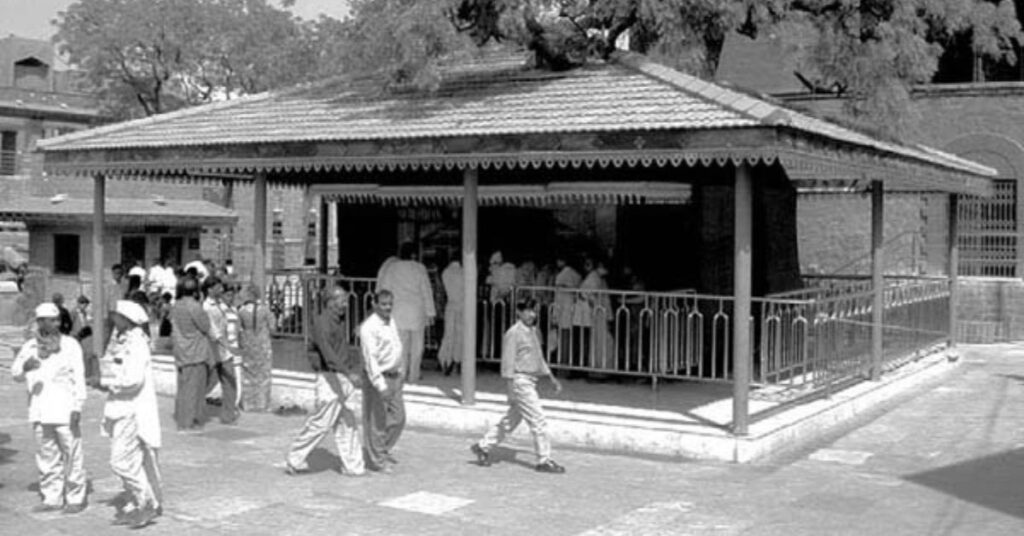
Step into Gurusthan, which translates to “place of the Guru,” and feel the weight of history settle around you. This revered spot is believed to be where Sai Baba first appeared in Shirdi, a young boy meditating beneath the shade of a neem tree. It’s a place that marks the beginning of his divine journey in this holy town.
A small shrine stands as a testament to this momentous event. Inside, a portrait of Sai Baba gazes out alongside a Shivalinga, a symbol of Lord Shiva. Devotees flock here, drawn by the belief that burning incense sticks at Gurusthan can bring peace, prosperity, and even cure ailments.
Lendi Baug:
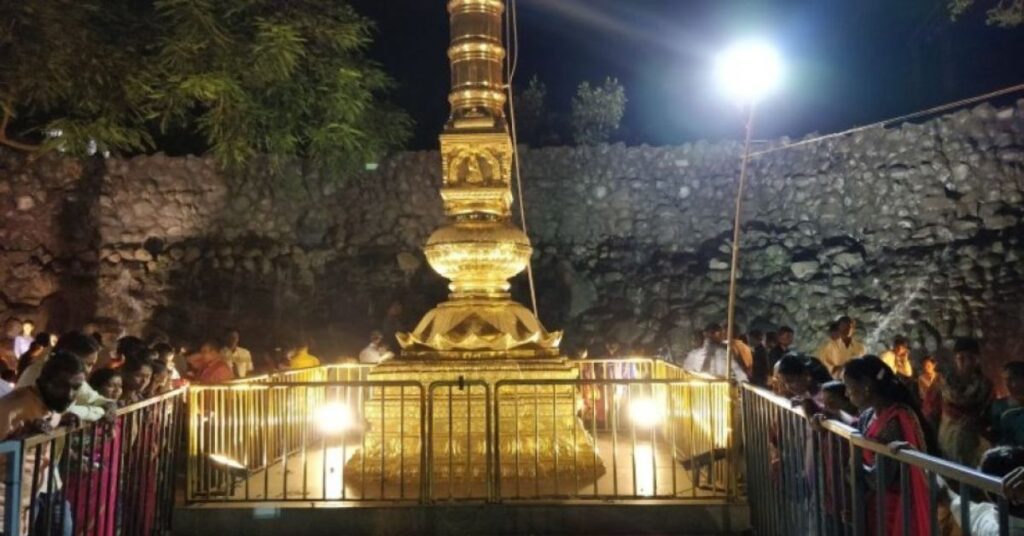
Tucked away in the heart of Shirdi’s spiritual landscape lies Lendi Baug, a serene garden that whispers stories of Sai Baba’s life. This verdant haven was a favored haunt of the saint, a place where he found solace and nurtured his connection with nature. Imagine Sai Baba himself, lost in meditation under the shade of a tree, or gently tending to the plants that brought him joy.
The centerpiece of Lendi Baug is the Nanda Deep, an ever-burning lamp that Sai Baba lit himself. It’s a powerful symbol – the eternal flame of knowledge and spirituality that continues to illuminate the path for devotees.
Sai Heritage Village:
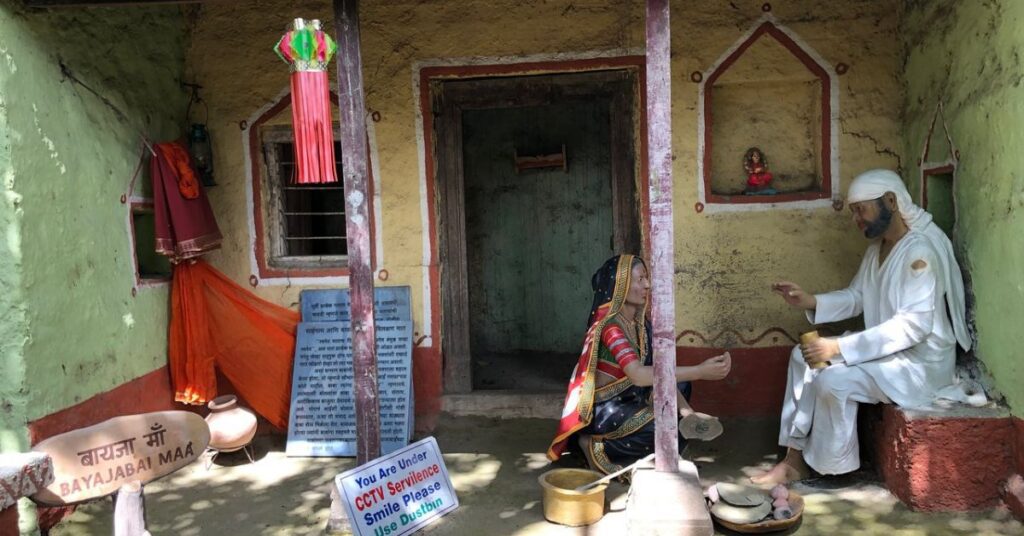
Step into Shirdi’s past at Sai Heritage Village, a one-of-a-kind experience that blends history, culture, and spirituality. This theme park isn’t your typical thrill-ride destination. Instead, it offers a captivating journey into the life and times of Sai Baba.
Imagine life-sized statues coming alive as you wander through the village. Dioramas recreate significant events from Sai Baba’s life – his legendary miracles, his profound teachings, and the heartwarming moments he shared with devotees. It’s a visual feast that brings history to life, allowing you to witness Sai Baba’s impact on the community firsthand.
Khandoba Mandir:
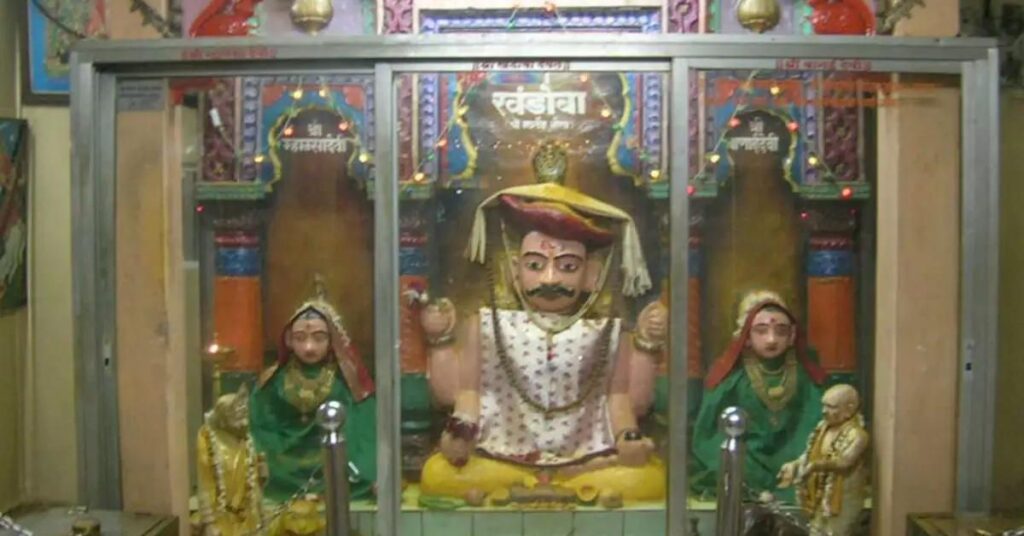
Unassuming yet significant, the Khandoba Mandir stands near Shirdi’s entrance, a quiet sentinel to the town’s spiritual history. Dedicated to Lord Khandoba, a manifestation of Lord Shiva, this temple holds a special place in the hearts of devotees. Legend whispers that it’s here a local priest first addressed Sai Baba as “Sai,” a name that would become synonymous with his divine presence.
Step inside the temple, and its simple structure belies its profound spiritual significance. Unlike some grand temples, Khandoba Mandir exudes a peaceful serenity.
Local Experiences:
- Witness the Aarti Ceremony: Immerse yourself in the uplifting atmosphere of morning and evening aartis at the Sai Baba Samadhi Mandir. Join devotees in chanting hymns and seeking blessings from the revered saint.
- Explore the Chavadi Procession: On Thursday nights, witness a vibrant procession reenacting Sai Baba’s journey from Dwarkamai to Chavadi. The air comes alive with music, chants, and the collective devotion of participants.
- Find Peace at Lendi Baug: Seek tranquility in the serene garden where Sai Baba himself meditated. Reflect beside the continuously burning Nanda Deep, a symbol of eternal knowledge and spirituality.
- Meditate at Dwarkamai: Step inside the unassuming mosque where Sai Baba resided. Feel the weight of history and immerse yourself in the peaceful atmosphere of this sacred site.
- Attend Spiritual Discourses: Delve deeper into spiritual wisdom by attending lectures and bhajan sessions held at various temples and community centers.
- Stay at an Ashram or Dharamshala: For a truly immersive experience, choose to stay at one of Shirdi’s many ashrams or dharamshalas offering simple and affordable accommodations.
- Explore the Bustling Bazaar: Wander through the vibrant markets near the temple complex. Discover unique souvenirs, religious items, and local handicrafts, taking home a piece of Shirdi’s charm.
- Savor Local Flavors: Indulge in traditional Maharashtrian cuisine at local eateries and restaurants. Sample specialties like Vada Pav, Poha, and Puran Poli, tantalizing your taste buds with regional delicacies.
- Celebrate Local Festivals: If your visit coincides with festivals like Ram Navami, Guru Purnima, or Sai Baba’s Punyatithi, witness the grand celebrations and rituals that paint Shirdi in a festive spirit.
- Take a Day Trip to Shani Shingnapur: Explore the nearby village famed for its unique temple dedicated to Lord Shani. Witness the fascinating custom of houses without doors, a testament to the villagers’ unwavering faith.
- Seek Thrills at Wet N Joy Water Park: Balance your spiritual journey with a fun-filled day at the local water park. Enjoy rides and attractions catering to all ages, creating a memorable experience for the whole family.
Travel tips:
- Book Ahead: Shirdi bustles with pilgrims, especially on weekends, holidays, and festivals. Secure your accommodation and travel tickets well in advance to avoid last-minute scrambles.
- Dress Modestly: Remember, Shirdi is a place of spiritual significance. Opt for comfortable, respectful clothing. Pack light, breathable fabrics for the warm climate, but bring a scarf or light jacket for evenings.
- Hydration is Key: The heat, particularly during summers, can be intense. Carry a reusable water bottle and stay hydrated throughout your visit.
- Footwear Matters: You’ll need to remove your shoes at temples and sacred sites. Choose comfortable sandals or slip-on shoes for easy removal.
- Getting Around: Auto-rickshaws and cycle-rickshaws are readily available for short distances within Shirdi. Negotiate fares clearly before your journey to avoid confusion.
- Local Customs: Be mindful of local customs and practices, especially in religious places. Maintain silence and follow guidelines at temples and other sacred sites.
- Prepare for Crowds: Be prepared for queues at popular attractions like the Sai Baba Samadhi Mandir. Early mornings or evenings might offer shorter wait times.
- Safety First: While Shirdi is generally safe, keep an eye on your belongings, especially in crowded areas. Avoid carrying excessive cash and secure valuables.
- Health Precautions: Monsoon season can bring waterborne illnesses. Pack a basic first-aid kit and any necessary medications.
- Guided Tours: Consider a local guide for deeper insights into Shirdi’s history and significance. They can also help you navigate and manage your visit efficiently.
- Mobile Connectivity: Shirdi has good mobile coverage, but carrying a portable charger ensures your phone stays powered for navigation and photos.
- ATM Availability: ATMs are available, but some vendors and local markets may only accept cash. Carry some rupees for convenience.
- Photography Restrictions: Photography is restricted in some areas, especially within the Sai Baba Samadhi Mandir. Be mindful of signs and respect the rules.
Conclusion
Shirdi beckons with its deep spirituality and vibrant culture, a place that touches every soul. Xplro.com can be your travel companion, whether you’re a Sai Baba devotee seeking blessings or a curious explorer yearning for peace. Uncover the town’s sacred heart at the Sai Baba Samadhi Mandir, immerse yourself in local customs at bustling bazaars, and join community rituals to gain a deeper understanding of Sai Baba’s legacy. With careful planning, respect for traditions, and an open heart, Xplro.com can help you craft a deeply enriching Shirdi journey, leaving you with a lasting sense of tranquility and fulfillment.
FAQs
How far is Shani Shingnapur from Shirdi?
- Shani Shingnapur is located approximately 70 kilometers from Shirdi, and it takes about 1.5 to 2 hours by road to reach there.
Are there direct flights to Shirdi?
- Yes, Shirdi has its own airport, Shirdi International Airport (SAG), which offers direct flights to major cities like Mumbai, Delhi, Hyderabad, and Bangalore.
What are the timings of aartis at Sai Baba Samadhi Mandir?
- Aartis are performed multiple times a day at Sai Baba Samadhi Mandir, including Kakad Aarti (morning), Madhyan Aarti (noon), Dhoop Aarti (evening), and Shej Aarti (night). It is advisable to check locally for exact timings as they may vary.
Is there an entry fee to visit Sai Baba Samadhi Mandir?
- No, there is no entry fee to visit Sai Baba Samadhi Mandir. However, donations are welcome and appreciated for the maintenance and upkeep of the temple.
What are the accommodation options in Shirdi?
- Shirdi offers a range of accommodation options including budget hotels, mid-range hotels, dharamshalas (guest houses), and luxury resorts. It is advisable to book in advance, especially during peak seasons.
Can I visit Shirdi for a day trip from nearby cities like Pune or Mumbai?
- Yes, Shirdi is accessible for day trips from cities like Pune (approximately 4-5 hours by road) and Mumbai (approximately 5-6 hours by road). Plan your trip well to maximize your time at the main attractions.
What are the local transportation options in Shirdi?
- Local transportation in Shirdi mainly includes auto-rickshaws, cycle-rickshaws, and taxis. These are readily available for travel within the town and to nearby attractions.
Is photography allowed inside Sai Baba Samadhi Mandir?
- Photography is generally restricted inside the inner sanctum of Sai Baba Samadhi Mandir and during aartis. Visitors are advised to respect these guidelines while taking photographs in other areas of the temple complex.
What should I wear while visiting temples in Shirdi?
- It is recommended to dress modestly and conservatively while visiting temples in Shirdi. Avoid wearing shorts, sleeveless tops, and revealing clothing out of respect for the religious sentiments of devotees.
Are there ATMs and medical facilities available in Shirdi?
- Yes, Shirdi has several ATMs and medical facilities, including hospitals and pharmacies, to cater to the needs of visitors.
Can I buy souvenirs and religious items in Shirdi?
- Yes, Shirdi has a bustling market near the temple complex where visitors can find a variety of souvenirs, religious items, books, and handicrafts related to Sai Baba and Hindu mythology.






